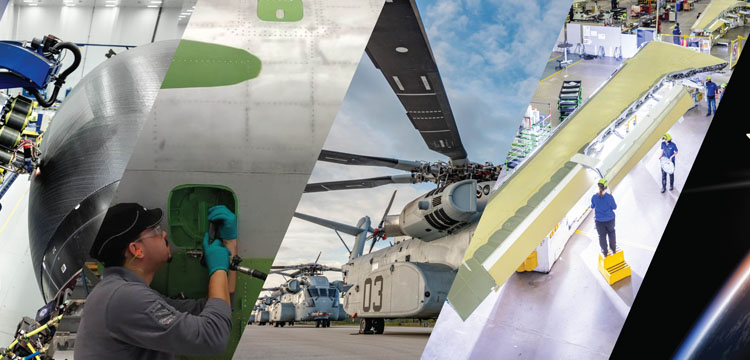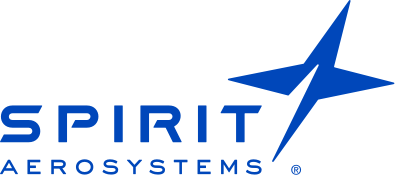

Fabricating the Future of Aircraft
New technology improves affordability and material efficiency

Imagine the force it takes to bend a titanium plate. Significant energy, specialized machinery and temperatures over 900 degrees Fahrenheit are needed to turn this incredibly strong material into useable parts.
Yet because of its high-strength to weight ratio, high temperature capability and ability to eliminate concerns of galvanic corrosion, it’s desirable for manufacturing aircraft – even with the material’s higher price point.
As one of the largest suppliers in aerospace, we recognize the material’s value. But we also know it is imperative to maintain high-quality while providing cost-effective options.
Through careful development in our Lean Metallic Structures Distinctive Capability research focus, Spirit has designed a unique process that mitigates cost and emphasizes sustainability, overall making working with titanium a cost-effective solution.
A cost- and material-efficient fabrication technology
Joule Form™ is a closed die hot forming technology that uses resistive heating to heat the work piece and then immediately form it via hydraulic pressure on the mating die sets. Doing it this way vastly improves cycle times, reduces tooling needs, enables rapid prototyping and R&D turnarounds, and minimizes formation of an undesirable “alpha case” layer. The technology is especially suitable for forming titanium parts less than 55 inches in length.

Joule Form was created to blend sustainability and efficiency efforts together. The technology has wide applicability for parts that would traditionally be hot formed. To know whether a part would benefit, there are three key characteristics: Buy-to-fly ratio, stress classification and part geometry.
Characteristic 1: Buy-to-fly ratio
Picture yourself standing in front of a giant block of marble. It is raw, uninteresting and seemingly devoid of character. Now imagine it has been carved into the statue of David. Marvelous, right?
When Michelangelo carved this phenomenal statue, he left some materials behind. But what if he had the ability to create his work without causing excess mess and wasting high-quality product?
Joule Form may not be producing marble statues, but a similar principle applies. A more efficient use of material.
The illustration below shows the waste reduction achievable with Joule Form. The left side of the picture shows three representative parts superimposed inside the large blocks of titanium that would be required to produce them with conventional processing techniques. The right side shows the same parts superimposed inside the much smaller pieces of titanium that Spirit can use instead, thanks to the Joule Form process. The difference is clear. Compared to Joule Form, traditional titanium processing wastes as much as three out of every four pounds of titanium purchased. In addition to driving material waste, the large amount of material to remove with traditional processes also means either additional machine time or an intermediate water jet reduction step.

Put simply, traditional titanium forming processes drive unnecessary cost by throwing much of the titanium used into the recycle bin.
With Joule Form, waste is significantly cut down. Less material waste means more cost-savings and better project outcomes.
Characteristic 2: Stress classification
Our team has completed extensive materials testing with Joule Form. The results show equivalence between base plate material allowables and material performance post-Joule Form for static and fatigue properties. Critical in aerospace applications, it ensures the analysis still demonstrates compliance with regulatory airworthiness requirements.
Parts using Joule Form have been implemented on an existing production program, analyzed using current methods and approved through both the customer and the appropriate engineering leaders within Spirit. Extending the application to damage tolerance critical parts remains an ongoing activity.
Characteristic 3: Part geometry
While the other two characteristics are instrumental, part geometry is the primary factor in determining a part’s candidacy for Joule Form. It affects both the raw material savings and machine time reduction, both of which offset the cost of Joule Form in the fabrication process.
Start by asking two questions:
- Can the part be formed from plate material?
- Will the formed blank be reasonably close to the final part configuration?
The focus should be on static and fatigue parts with high buy-to-fly ratios and part geometries that can be formed from a plate.
For initial implementation, Joule Form is applied to existing part configurations. But when new part designs are optimized to the most appropriate fabrication methodology, additional long-term benefits are possible.
A few examples:
An excellent candidate for Joule Form is shown below. It’s formed from plate material, and the resulting blank would be close to the final form, minimizing machining time.

Conversely, the part below is a weak candidate. The boss drives a thicker raw material and a high buy-to-fly ratio, even after employing Joule Form.

Finally, an example of geometry where forming is not a viable option.

In comparison to other fabrication methodologies commonly used today, Joule Form has demonstrated strong benefits in total part cost, summarized with relative benefits below.

Total part cost is a complex balance between raw material cost, intermediate process steps, machine time and any additional processes required by the different fabrication approaches.
As an example, die forgings are applicable to very complex geometries but are expensive from a raw material standpoint and typically require lower machining times. Machining from thick plate or block material has a lower raw material cost but drives material waste and additional machine time.
Where the geometry is a good fit, Joule Form exhibits the best of all worlds: low raw material cost (standard Ti plate), reasonable intermediate process costs and minimal machine times.
The future of aircraft with Joule Form
Aviation needs more affordable, sustainable aircraft. The future of Joule Form™ has the potential to go beyond the material types and geometries as we’ve discussed here. In future development, we’re focused on additional hard metals, CRES and Inconel and titanium sheet forming to extend Joule Form’s ability to decrease the total cost of parts. We may not be chiseling statues from marble, but together, we can create a future that’s just as high-quality yet more cost-effective.



